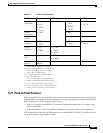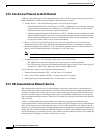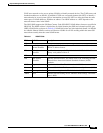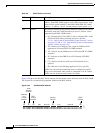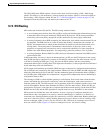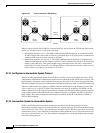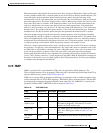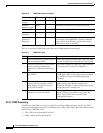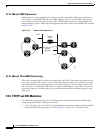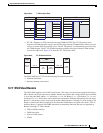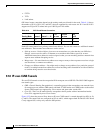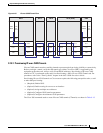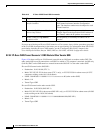
9-34
Cisco ONS 15600 Reference Manual, R7.2
Chapter 9 Management Network Connectivity
9.7.5 TARP
Table 9-11 shows the TARP PDUs types that govern TARP interaction and routing.
9.7.5.1 TARP Processing
A TARP data cache (TDC) is created at each NE to facilitate TARP processing. In CTC, the TDC is
displayed and managed on the node view Maintenance > OSI > TDC subtab. The TDC subtab contains
the following TARP PDU fields:
•
TID—TID of the originating NE (tar-tor).
•
NSAP—NSAP of the originating NE.
TID Originator
Length
tar-oln 1 The number of octets that are in the tar-tor field.
Protocol
Address Length
tar-pln 1 The number of octets that are in the tar-por field.
TID of Target tar-ttg n = 0, 1, 2... TID value for the target NE.
TID of
Originator
tar-tor n = 0, 1, 2... TID value of the TARP PDU originator.
Protocol
Address of
Originator
tar-por n = 0, 1, 2... Protocol address (for the protocol type identified in the
tar-pro field) of the TARP PDU originator. When the
tar-pro field is set to FE (hex), tar-por will contain a
CLNP address (that is, the NET).
Table 9-10 TARP PDU Fields (continued)
Field Abbreviation Size (bytes) Description
Table 9-11 TARP PDU Types
Type Description Procedure
1 Sent when a device has a TID for which
it has no matching NSAP.
After an NE originates a TARP Type 1 PDU, the PDU
is sent to all adjacencies within the NE’s routing area.
2 Sent when a device has a TID for which
it has no matching NSAP and no
response was received from the Type 1
PDU.
After an NE originates a TARP Type 2 PDU, the PDU
is sent to all Level 1 and Level 2 neighbors.
3 Sent as a response to Type 1, Type 2, or
Type 5 PDUs.
After a TARP Request (Type 1 or 2) PDU is received,
a TARP Type 3 PDU is sent to the request originator.
Type 3 PDUs do not use the TARP propagation
procedures.
4 Sent as a notification when a change
occurs locally, for example, a TID or
NSAP change. It might also be sent
when an NE initializes.
A Type 4 PDU is a notification of a TID or Protocol
Address change at the NE that originates the
notification. The PDU is sent to all adjacencies inside
and outside the NE’s routing area.
5 Sent when a device needs a TID that
corresponds to a specific NSAP.
When a Type 5 PDU is sent, the CLNP destination
address is known, so the PDU is sent to only that
address. Type 5 PDUs do not use the TARP
propagation procedures.




